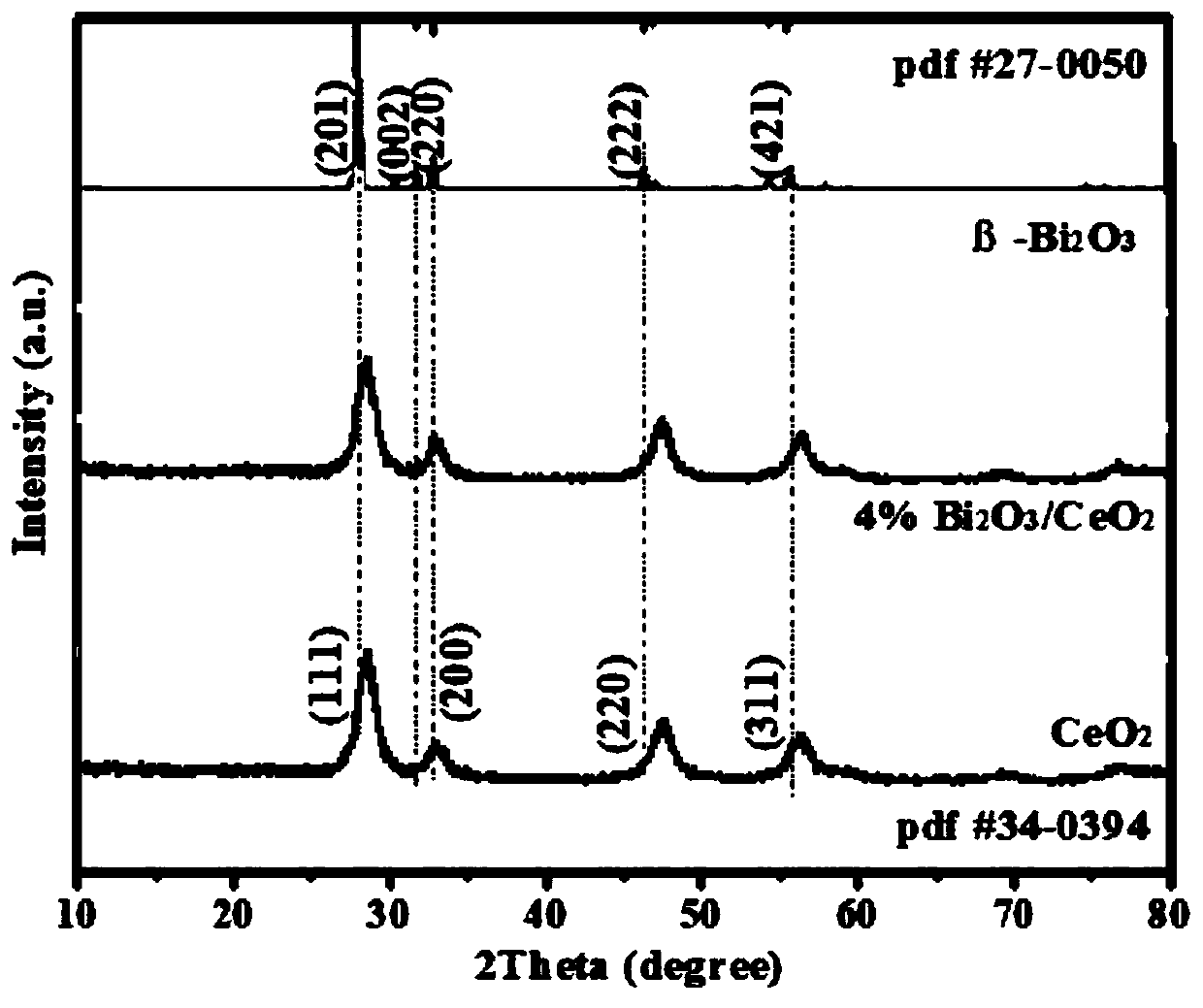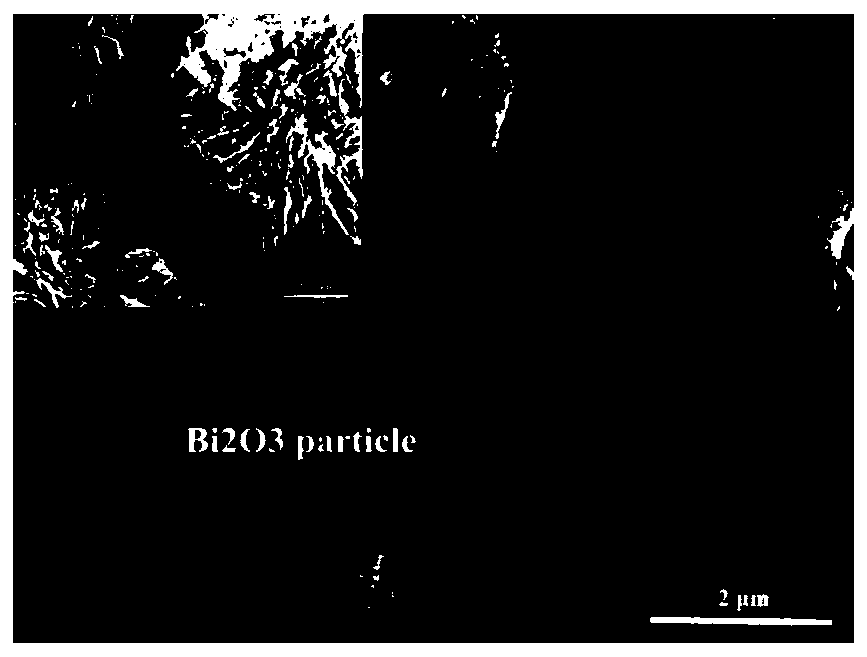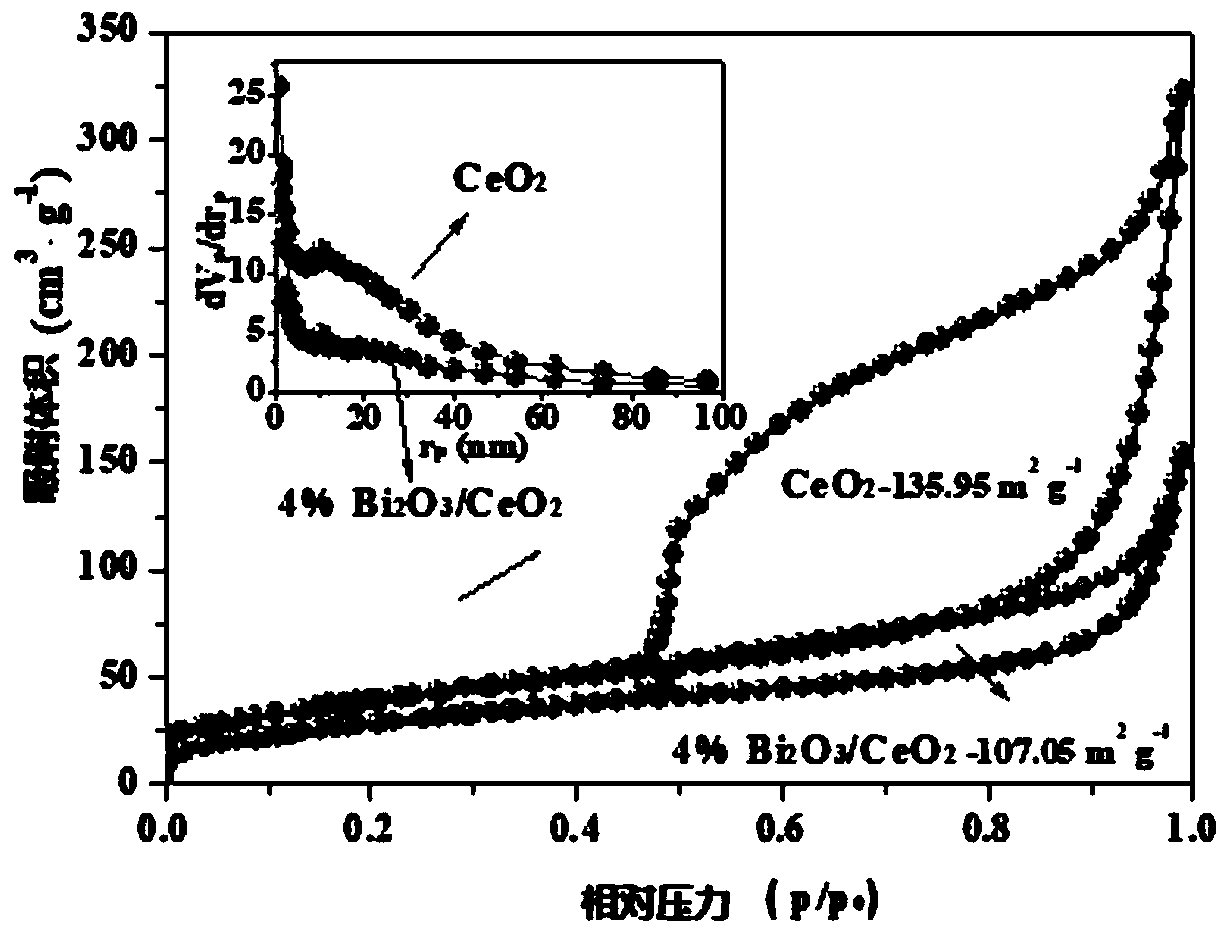Z-mechanism Bi2O3@CeO2 photocatalyst rich in oxygen vacancy, and preparation method and application thereof
A photocatalyst, oxygen vacancy technology, applied in the field of photocatalysis, can solve the problems of high photo-generated electron-hole recombination rate and low utilization rate of photocatalyst, achieve high catalytic degradation activity, fast degradation rate, improve electrical conductivity and oxidation effect of ability
- Summary
- Abstract
- Description
- Claims
- Application Information
AI Technical Summary
Problems solved by technology
Method used
Image
Examples
Embodiment 1
[0032] Oxygen vacancy-rich Z-mechanism Bi 2 o 3 @CeO 2 The preparation method of photocatalyst, it comprises the steps:
[0033] 1) Preparation of reaction solution
[0034] a. Dissolve 2 g of cerium nitrate hexahydrate in 60 mL of deionized water to form a uniform solution, then add 0.8 g of acrylamide and 1.8 g of glucose and stir for 20 minutes to prepare a cerium nitrate solution;
[0035] b. Bi(NO 3 ) 3 ·5H 2 O was dissolved in ethylene glycol solution and stirred for 20 minutes until the solution was uniform to prepare bismuth nitrate solution;
[0036] 2) Slowly drop the bismuth nitrate solution prepared in step 2) into the cerium nitrate solution prepared in step 1) according to the atomic ratio of Ce:Bi=1:0.04 and stir for 20 minutes, and use ammonia with a volume concentration of 5%. The pH of the aqueous solution was adjusted to 10, stirred for another 3 hours, and then transferred into a stainless steel reaction kettle for hydrothermal reaction at 180° C. fo...
Embodiment 2
[0042] Different from Example 1, the oxygen-vacancy-rich Z-mechanism Bi prepared in this example 2 o 3 @CeO 2 The preparation method of photocatalyst comprises the following steps:
[0043] 1) Preparation of reaction solution
[0044] a. Dissolve 2.5 g of cerium nitrate hexahydrate in 50 mL of deionized water to form a uniform solution, then add 1 g of acrylamide and 1.6 g of glucose and stir for 28 minutes to prepare a cerium nitrate solution;
[0045] b. Bi(NO 3 ) 3 ·5H 2 O was dissolved in ethylene glycol solution and stirred for 26 minutes until the solution was uniform to prepare bismuth nitrate solution;
[0046] 2) Slowly drop the bismuth nitrate solution prepared in step 2) into the cerium nitrate solution prepared in step 1) according to the atomic ratio of Ce:Bi=1:0.04 and stir for 26 minutes, and use ammonia with a volume concentration of 7% The pH of the aqueous solution was adjusted to 10, and then stirred for 2.5 hours, then transferred into a stainless st...
Embodiment 3
[0051] Different from Example 1 and Example 2, the oxygen-vacancy-rich Z-mechanism Bi prepared in this example 2 o 3 @CeO 2 The preparation method of photocatalyst comprises the following steps:
[0052] 1) Preparation of reaction solution
[0053] a. Dissolve 3 g of cerium nitrate hexahydrate in 60 mL of deionized water to form a uniform solution, then add 1.2 g of acrylamide and 2 g of glucose and stir for 30 minutes to prepare a cerium nitrate solution;
[0054] b. Bi(NO 3 ) 3 ·5H 2 O was dissolved in ethylene glycol solution and stirred for 30 minutes until the solution was uniform to prepare bismuth nitrate solution;
[0055] 2) Slowly drop the bismuth nitrate solution prepared in step 2) into the cerium nitrate solution prepared in step 1) according to the atomic ratio of Ce:Bi=1:0.05 and stir for 30 minutes, and use ammonia with a volume concentration of 5.5%. The pH of the aqueous solution was adjusted to 11, stirred for another 3 hours, and then transferred int...
PUM
| Property | Measurement | Unit |
|---|---|---|
| Diameter | aaaaa | aaaaa |
| Thickness | aaaaa | aaaaa |
| Diameter | aaaaa | aaaaa |
Abstract
Description
Claims
Application Information
 Login to View More
Login to View More - R&D
- Intellectual Property
- Life Sciences
- Materials
- Tech Scout
- Unparalleled Data Quality
- Higher Quality Content
- 60% Fewer Hallucinations
Browse by: Latest US Patents, China's latest patents, Technical Efficacy Thesaurus, Application Domain, Technology Topic, Popular Technical Reports.
© 2025 PatSnap. All rights reserved.Legal|Privacy policy|Modern Slavery Act Transparency Statement|Sitemap|About US| Contact US: help@patsnap.com



